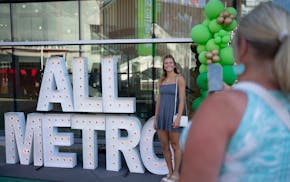Besides talent spotting, open-call juried shows are a great sampling of the zeitgeist. Rummaging through boatloads of art, jurors may spy a stylistic trend or theme. Suddenly angst is in the air, or shamrock green is trending, or rabid politics gnaws the collective unconscious. Skulls have been so popular of late that some jurors have banned them. Ditto animé characters, graffiti and bathroom plumbing.
Winnowing the 190 applicants for "Untitled 11," the 11th annual juried show at Soo Visual Arts Center, jurors Caroline Kent and Tom Rassieur chose thoughtful, low-key, well-designed art that dodged the clichés du jour. No urinals! What's not to like?
Kent, a St. Paul-based artist and co-founder of the alternative exhibition space the Bindery Project, and Rassieur, curator of prints and drawings at the Minneapolis Institute of Arts, picked just 18 artists, each of whom is represented by one or more objects — photos, sculpture, paintings, graphic designs, an animated film. The show runs through Dec. 28.
The show's most unusual piece, Adam White's "The Second Will," consists of hundreds of tiny conversation bubbles mounted in overlapping, 3-D lines within a picture frame. Clipped from a comic strip or graphic novel, the bubbles read as a stream-of-consciousness murder mystery in some far-out dimension. Though made only of words, the construction cleverly evokes continually changing mental pictures as it is scanned.
There's a charming naiveté to Kelly Meister's digital-collage video "Where Do We Go From Here?" in which drawings of animals (dogs, beaver, bunnies, birds) race through a watercolor wilderness intercut with waterfall footage and drawings of increasingly polluted cities. The rough production values are a good fit with critters in desperate search of a haven.
As a traditional painter, Aaron Kagan Putt also has effectively matched his medium to his message. In two portraits he depicts guys whose brains have essentially been replaced by tangled fields of power lines and electronic gizmos. Only their mouths and torsos recall their fleshy nature. In his "Marginalized Self" portrait, Douglas Brull also uses diverse media to suggest alienation by covering photos of his face with a paper mask, a square of blue paper propped up with a 2-by-2 board, and so on.
Didactic urgency
Race, violence, poverty and exploitation are addressed with didactic urgency elsewhere.
Kyle Johnson articulates the nation's ambivalence about President Obama's race in a pixilated color photo of the president on which he has written the words "not white enough." It's paired with an identical photo, covered with a thin veil of whitewash marked "not black enough." Chris Scott's sculpture "Candy for My Baby" effectively takes a gibe at the omnipresence of guns and ammo in American life by dispensing porcelain bullets from a vending machine. Christopher Harrison deals with labor abuse and starvation in two small, tombstone-shaped paintings: "Gold Standard," in which a worker's gaunt ribs are visible through a mist of gold, and "Bloody Sunday," in which lava-thick red paint rolls down toward a huddle of starving children. And Byron Anway produced two small oils, "Fight," in which a boisterous crowd reaches toward a guy in midair, and "Silence," in which guys in suits are restraining and muzzling one of their own.
There are also quirky designs. Ana Taylor's four "Wisconsin Mythologies" are amusing, orange-legged characters collaged from photos and drawings of antlers, feathers, tablecloths and so on. Diana Behl makes nicely balanced abstractions from scribbles, stripes, grids and geometric shapes. The blue abstractions in Margaret Pezalla-Granlund's "Dream Objects" cyanotypes were somehow inspired by memory and a residency at the Museum of Jurassic Technology. And Keren Kroul has expressed an "Unquiet Mind" as an eight-panel aerial map of irregular crystalline shapes in blue and green.
Tackling issues
Beyond that, much of the art nods at troubling issues but leaves them mired in obscurity or addresses them so obliquely as to offer little insight.
Photographer Laura Crosby, for example, offers a nicely composed black-and-white photo titled "Sex Trafficking Via the Rear View Mirror." It shows a half-dozen casually dressed men and women, all African-American, at the edge of a grassy lot or park at midday. One woman is speaking to someone in a passing van; another is seen approaching in a rear-view mirror. A similar group clusters on the opposite side of the park. Maybe they are sex traffickers, but there's scant visual support for that narrative.
Environmental topics may lurk in odd corners such as Sho Nikaido's "Bouquet for the Sunset U've Never Seen," which pairs 14 humdrum color photos (beach foam, pond scum, red-leather auto interior, guy at chain-link fence, etc.) with a pleasantly innocuous soundtrack. Or in Kelsey Bosch's minimalist photo and attractive heap of cast iron, charcoal and pretty bits of aqua plastic-looking stuff. Or in Stephen Stephens' nice color photos of grasses, asphalt piles and road salt. Or in the cool-looking backlit discs of amber "microbial culture" that Jamie Winter Dawson has unhelpfully titled "Inception Retained."
Probably such art has something to do with nature and human meddling. But aside from the oddity, exoticism and prettiness of the images, their point is opaque.
Mary Abbe • 612-673-4431

What to know about the latest COVID variants, Minnesota testing, vaccines
Sign up for Star Tribune newsletters

126 birds on list 'lost to science'


